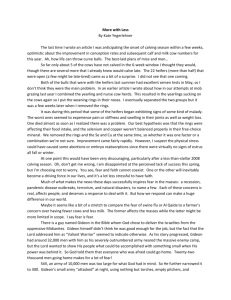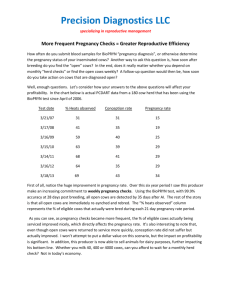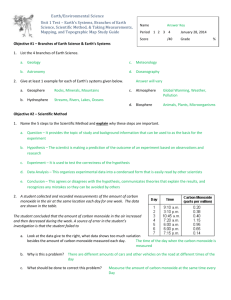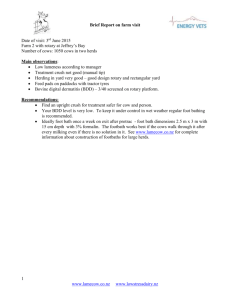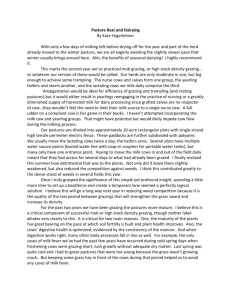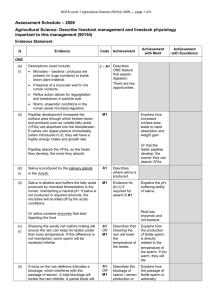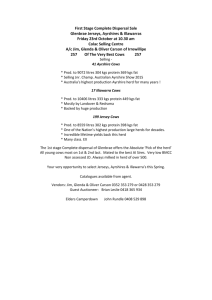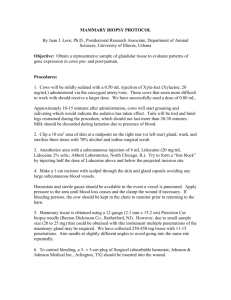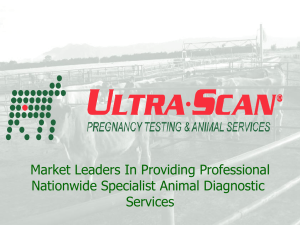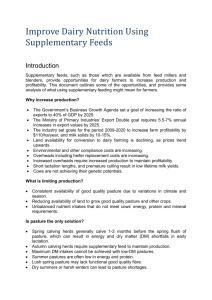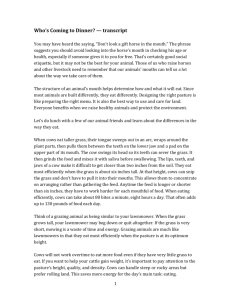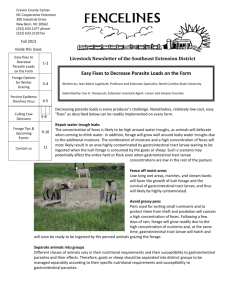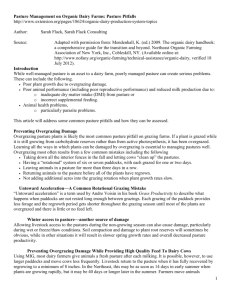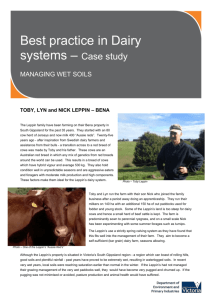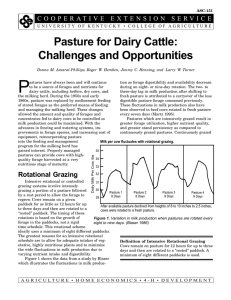Biggest Obstacle - The Swiss Connection
advertisement
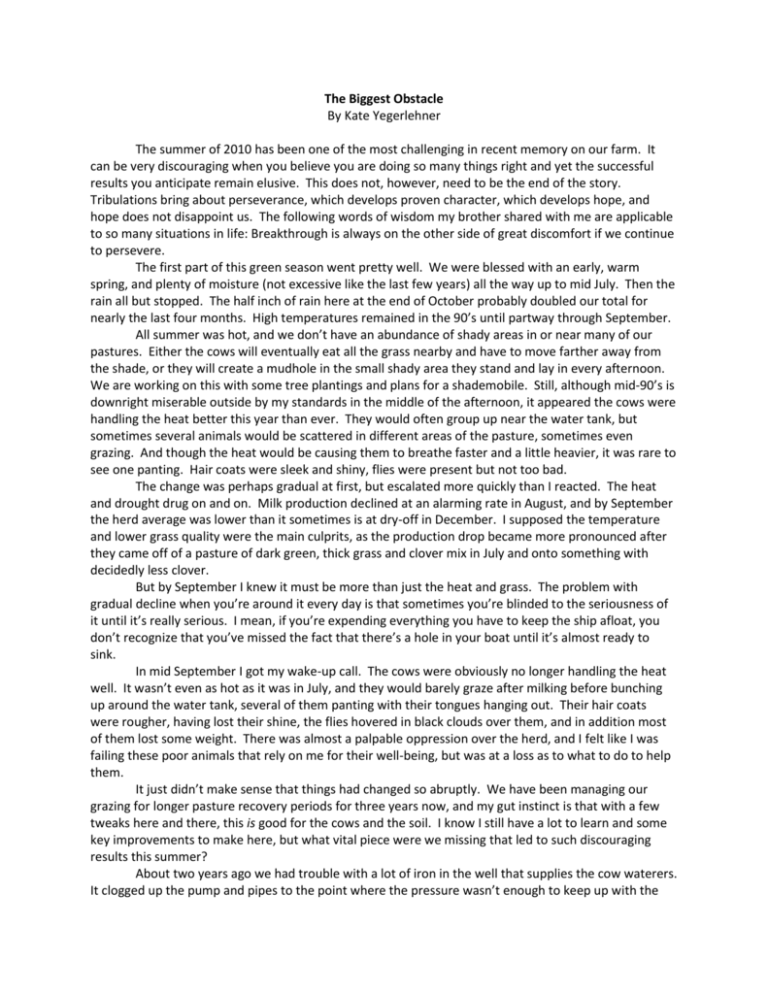
The Biggest Obstacle By Kate Yegerlehner The summer of 2010 has been one of the most challenging in recent memory on our farm. It can be very discouraging when you believe you are doing so many things right and yet the successful results you anticipate remain elusive. This does not, however, need to be the end of the story. Tribulations bring about perseverance, which develops proven character, which develops hope, and hope does not disappoint us. The following words of wisdom my brother shared with me are applicable to so many situations in life: Breakthrough is always on the other side of great discomfort if we continue to persevere. The first part of this green season went pretty well. We were blessed with an early, warm spring, and plenty of moisture (not excessive like the last few years) all the way up to mid July. Then the rain all but stopped. The half inch of rain here at the end of October probably doubled our total for nearly the last four months. High temperatures remained in the 90’s until partway through September. All summer was hot, and we don’t have an abundance of shady areas in or near many of our pastures. Either the cows will eventually eat all the grass nearby and have to move farther away from the shade, or they will create a mudhole in the small shady area they stand and lay in every afternoon. We are working on this with some tree plantings and plans for a shademobile. Still, although mid-90’s is downright miserable outside by my standards in the middle of the afternoon, it appeared the cows were handling the heat better this year than ever. They would often group up near the water tank, but sometimes several animals would be scattered in different areas of the pasture, sometimes even grazing. And though the heat would be causing them to breathe faster and a little heavier, it was rare to see one panting. Hair coats were sleek and shiny, flies were present but not too bad. The change was perhaps gradual at first, but escalated more quickly than I reacted. The heat and drought drug on and on. Milk production declined at an alarming rate in August, and by September the herd average was lower than it sometimes is at dry-off in December. I supposed the temperature and lower grass quality were the main culprits, as the production drop became more pronounced after they came off of a pasture of dark green, thick grass and clover mix in July and onto something with decidedly less clover. But by September I knew it must be more than just the heat and grass. The problem with gradual decline when you’re around it every day is that sometimes you’re blinded to the seriousness of it until it’s really serious. I mean, if you’re expending everything you have to keep the ship afloat, you don’t recognize that you’ve missed the fact that there’s a hole in your boat until it’s almost ready to sink. In mid September I got my wake-up call. The cows were obviously no longer handling the heat well. It wasn’t even as hot as it was in July, and they would barely graze after milking before bunching up around the water tank, several of them panting with their tongues hanging out. Their hair coats were rougher, having lost their shine, the flies hovered in black clouds over them, and in addition most of them lost some weight. There was almost a palpable oppression over the herd, and I felt like I was failing these poor animals that rely on me for their well-being, but was at a loss as to what to do to help them. It just didn’t make sense that things had changed so abruptly. We have been managing our grazing for longer pasture recovery periods for three years now, and my gut instinct is that with a few tweaks here and there, this is good for the cows and the soil. I know I still have a lot to learn and some key improvements to make here, but what vital piece were we missing that led to such discouraging results this summer? About two years ago we had trouble with a lot of iron in the well that supplies the cow waterers. It clogged up the pump and pipes to the point where the pressure wasn’t enough to keep up with the cows drinking. One day Dad noticed the cows drinking out of the creek on the way to the barn immediately after walking past their water tank in the pasture. As he was contemplating this, he saw in his mind’s eye a bowl of salt. Then he remembered how in 2 Kings, the prophet Elisha had come to a town with a spring of bitter water, and there was infertility in the land. Elisha told the people to put a bowl of salt in the spring, and the waters were “healed.” So Dad decided we should put a bowl of salt in our well. After an onslaught of orange water coming through the lines, it cleared and the water pressure improved greatly. Let’s just say we rejoiced at our miracle. Some time after this my cousin told me about iron-producing bacteria, which puts a scientific explanation behind the miracle. This summer I began noticing more little rust pieces coming back through the water lines, and more orange water as well. There was a hole in my boat, I think. My parents had taken a much-needed vacation in mid-September, and the morning after their return as Dad and I were walking out to bring the cows in for milking, he told me he had been thinking quite a bit while he was away about Jesus’ words about being the salt of the earth. He had also been considering applying some sea salt this fall to the pastures for soil mineralization. I asked if he thought we should put salt in the well again. He did that evening. The next morning we proceeded to the pasture. Instead of finding at daybreak the whole herd huddled around the water tank as was customary of late, they were spread out over the pasture. It was just as hot as it had been the morning before, but they actually grazed after milking. It was as if this giant burden had been lifted off of them, and I believe I could literally feel their relief. There is no doubt in my mind that something big happened with the salt. First, since that day the water (which turned bright orange again for a while and transported plenty of sediment) has cleared up again. Additionally, milk production has returned to more of a normal level for our herd at this stage of lactation, the cows’ hair coats have improved, and most of them have gained weight. While I have theories, what I don’t know is exactly what problem was corrected and how. I suspect iron toxicity was one thing that led to the crisis. Some of the symptoms of too much iron in the body matched or could lead to what I was seeing in the cows. One example is arthritis, and a few of my nurse cows developed some joint problems during this time period. Putting salt in the well would certainly be a way of controlling the bacteria. An unseen force may also have been playing a role in the difficulties, about which I only have a scratch-the-surface kind of basic understanding. Underground lay lines and energy fields caused by various types of digital and electrical current have an impact on living tissue (which itself is composed of molecules, atoms… positively charged protons and negatively charged electrons…). When exposed to these energy fields for long periods of time, the body is affected in a host of ways that are far from positive. We have known for several years that some lay lines cross our farm in a number of places. This summer we extended our buried water lines in the pastures far from the barn, and we have theorized that perhaps if these lines intersected a lay line it could have been charging the water over the whole farm. The suspicion is particularly justified since the beginning of the problems closely coincided with the completion of the water line project. Exactly how the sea salt remedied this issue I’m not sure. But there is undoubtedly information out there that would shed some light on the subject. There are many obstacles that can provide strong opposition to the success in our lives and businesses. Some can have serious, even irreparable consequences if allowed to go unchecked. What I have been reminded of this summer is that the biggest obstacle is often found between my ears. My discouragement led me to a mental quagmire. That is the birthplace of hopelessness. Just because I don’t have the resources to understand or combat a certain problem doesn’t mean no one does. Setting my mind on the pursuit of that which addresses and even fights against the obstacle is half the battle. Perseverance in the face of trials is the prerequisite for being an overcomer.




